.png?width=300&name=MicrosoftTeams-image%20(42).png)
DECEMBER 2022
CHECKING IT TWICE
Table of Contents
Getting Back in Person
We’re making a list, checking it twice…
As the year winds down, we often find ourselves in a reflective state. We look back at the year to see what went well, where to improve for next year, and determine where we can go from here. For many, 2022 was the year that started to feel more normal. We have started to settle into our new routines and have more of a clear vision where things will be headed in the months to come.
That is not to say there are not challenges on the horizon. The healthcare industry continues to be turbulent, with financial and societal pressures fueling rapid change for facilities of all sizes. Social inflation also continues to impact claims results across the nation. Watching the data and keeping an eye on trends continues to be an essential component of business strategy.
In this issue, we have gathered a variety of lists that we find ourselves checking twice as the year comes to a close. Some allow us to reflect on the work that has been done as we position ourselves to take on 2023. Some are simply a way to look back and take pride in the tools that we developed in service of our insureds, or you, our agency partners.
We hope your year is moving toward a calm and joyous close, and we look forward to our continued mutual success in the years to come.
Wishing you and yours the very best this holiday season—and a healthy and prosperous new year!

2022 In Review
For ProAssurance, 2022 was an amazing year—not only for our organization but for the community of agency partners who have grown with us. Before we jump into 2023, let’s look back at some of the memorable moments of the last year and see what we’ve achieved together.
Leveraging Our Position
Our first full year following the NORCAL transaction laid the foundation for our work as a combined organization, creating a unified set of goals and aligning our strategic priorities. The continued growth throughout 2022 reflected the strategic value, scope, scale, and data advantage of the NORCAL transaction.
“The NORCAL acquisition continues to contribute top-line growth, resulting in increased gross written premium,” said Mike Boguski, President, Specialty P&C. “We are pleased with the strategic value that the NORCAL transaction continues to deliver to the organization.”
In the third quarter 2022, gross written premiums increased 1%, and the 29% increase in top-line premium through nine months was driven by the NORCAL acquisition.
Our strong commitment to our insureds and agency partners is reflected by a near 90% retention rate over the last year. “And the continued focus on our strategic transformation—NORCAL integration, systems consolidation, and operational workflow improvements—has all been executed very, very well,” added Boguski.
Financial Highlights
Specialty P&C segment results for the most recent quarter were highlighted by improved loss ratios and continued improvement in premium retention and continued benefits from integration and operational excellence strategies.
Gross premiums written of $308 million were in line with a year ago and driven by strong premium retention and renewal pricing increases. Exclusive of a total 3.9 percentage point impact from purchase accounting in the third quarter, the combined ratio improved 1.5 percentage points as compared to the third quarter of 2021.
Premium retention in the segment was 87%, an improvement of 3 percentage points over 2021. Overall, renewal pricing increases were 8% in the quarter. New business was approximately $12 million in the quarter, up from $11 million in the third quarter of 2021, as we faced the challenges of a competitive marketplace.
“Third quarter’s results were noteworthy for the strong client retention and improved pricing in the Specialty P&C segment, which produced an increase in gross written premium,” said Ned Rand, ProAssurance President and CEO. “Our reputation for client service is a differentiator that delivers value for our policyholders and provides loyalty in a competitive market.”

Organizational Changes
This past year we completed the execution of the HCPL organizational structure changes that we announced and launched in 2021 to transform our competitive position and integrate NORCAL. The HCPL five-region organizational structure was implemented in late 2021 to align Underwriting, Claims, Business Development, and Risk Management on a regional basis to deliver superior service to our agency partners and customers. We facilitated collaboration across HCPL’s five geographic regions to increase synergies and business development opportunities. We also fully implemented and staffed the HCPL production underwriting and business development models.
Our position as one of a small handful of specialist HCPL companies with a national platform and the ability to write both standard physicians and specialty business means we are currently ahead of most in the market in despite the challenges.
Challenges
Over the past year, we continued to see a volatile market with outsized jury verdicts and severity prevalent. While the primary driver of increased severity is social inflation resulting from unpredictable jury behavior and attitudes toward institutions/expert authority figures, other contributing factors include higher defense costs such as expert witness fees, higher demands from plaintiff attorneys, and medical care inflation. Although “nuclear verdicts” can be reduced or overturned on appeal, their direct costs are still significant, and the publicity generated by the initial award serves to raise the bar on future plaintiff attorney demands and expectations.
In addition, AM Best maintained a negative outlook on the MPL sector partially due to rate adequacy concerns and rising loss cost trends.
Transformation, Sustainability, and Innovation
Our ability to survive and thrive in a challenging and shrinking MPL industry in a way that is fiscally sustainable through the insurance and economic cycles requires us to transform our business through product, technology, and other innovations.
Over the past year, we have capitalized on the national platform we now operate in via the NORCAL acquisition by gaining efficiencies and reducing expenses through technology beginning with the consolidation of IT systems. We are using technology to deliver best-in-class customer service via the Enterprise Digital Experience team and other units of the newly formed Business Operations, Logistics, and Transformation (BOLT) department.
We have also leveraged the advantage of the data available from being the third largest MPL carrier and our third-party analytics partner relationship for accurate pricing, loss experience stability, and improved customer acquisition targeting.
Growth Initiatives
It’s no surprise that new business has been difficult to come by during the pandemic. Failure to write adequate new business means we shrink—even carriers with the highest retention must replace 10% of their business each year to maintain level premiums. While product development will play a major part in growth and improved retention will lessen the pressure, we believe specific growth initiatives are important. In 2022, these included:
- Completing our production underwriting implementation
- Focusing the Business Development department on revenue generation
- Continued disciplined underwriting, product diversity, and focused creativity
- Hospital growth in core states
- Improving the distribution system in Senior Care
- Increased assumed reinsurance and Inova segregated portfolio cell (captive) business
We did see solid retention and rate gains in the Specialty P&C segment. In this competitive market, the strong retention is a testament to the efforts and dedication of our operational teams, as our customer focus continues to make ProAssurance an appealing choice for our insureds.
Looking Ahead
Our next step is to maintain our momentum into 2023. “We believe all of these efforts are positioning the company well as we navigate the challenges of competitive pricing and economic and social inflation,” said Boguski. “We are confident in our ability to manage through this challenging environment.”
Rand added, “It’s been a couple of years of change for all of us, and we believe that the reliability and customer focus of our operational teams, coupled with a long-standing reputation for excellence, make ProAssurance an appealing choice for insureds in a competitive marketplace.”
We are looking forward to continuing to be the carrier of choice for our agency partners. Thank you for being such an integral part of our growth this year. We can’t wait to see what we accomplish together in 2023.
|
|
|

Laws Passed
A number of items were signed into law throughout the country in 2022 that have a direct impact on the healthcare liability industry. The list below, compiled with assistance from the MPL Association, reflects those legislative changes. This does not include ballot measures that were voted on in the 2022 midterm elections.
HB 2449—Signed 4/25/22
Civil liability protections for healthcare institutions from death/injury from communicable disease from clergy visitations.
HB 2126—Signed 3/29/22
Companies must now notify the Director of AZDOHS if over 1,000 individuals are affected by a cyber breach.
AB 2098—Signed 9/30/22
Designates COVID-19 dissemination of misinformation or disinformation as unprofessional conduct.
AB 35—Signed 5/23/22 – Effective 1/1/2023
Amends the Medical Injury Compensation Reform Act of 1975.
HB 22-1272—Signed 6/8/22
Eliminates current provision allowing a defendant to be awarded attorney fees in tort actions if the case is dismissed on a motion of the defendant prior to trial.
HB 22-1071—Signed 3/21/22
Allows a successful plaintiff to recover actual damages, injunctive relief allowed by law, and reasonable attorneys fees and costs.
B 24-0061—Signed 11/21/22
Prohibits factoring in race, ethnicity, or gender when determining future damages for lost earnings or reduced earning capacity in MPL claims.
SB 1062—Signed into law 6/15/22
Clarifies the notification process for MPL claims, clarifies tolling statute of limitations, and expands methods of serving a notice of MPL litigation.
SB 7014—Approved by Governor 2/24/22
This bill extends the sunset date of COVID-19 liability protections through June 1, 2023.
HB 478—Effective 7/1/22
Technical changes to existing law governing expert witness standards in civil proceedings.
SB 403—Signed 5/9/22
Provides civil liability protections for healthcare providers and entities in connection with transporting behavioral health patients.
HB 961—Signed into law 5/13/22
This bill would amend state law to allow for apportionment of damages in single-defendant lawsuits. It also provides for evidence of fault of nonparties.
H 444—Signed into law 2/24/22 – Effective 7/1/22
This bill extends COVID-19 exposure liability law for another year, until July 1, 2023. Protections apply to broad business community, including healthcare professionals and facilities.
SB 1099—Signed 5/27/22
Updates to regulations for litigation funding.
HB 2279—Approved by Governor 4/15/22
Requires APRNs to maintain and provide proof of professional liability insurance when practicing or renewing their license in Kansas.
SB 150—Approved by Governor 4/25/22
Regulates lawsuit advertising practices and restricts the use/disclosure of PHI to solicit individuals for legal services.
HB 474—Signed 4/8/22
Adopts a variation of the NAIC’s Insurance Data Security Model Act.
HB 896—Signed 6/14/22
Revises collateral source provisions to include insurance payments, Medicare, and Medicaid. Also eliminates the exception for claims brought against the state.
SB 207—Signed 4/21/22
Requires insurers to establish a cybersecurity program and implement a cyber breach notification and investigation plan. HIPAA-compliant organizations are exempt.
SB 167—Signed 4/12/22
Allows the Insurance Commissioner to require an insurer to fulfill policy obligations or pay claims/the amount due under the policy.
H 4345—Signed 3/30/22 – Retroactively effective 11/22/21
Revives civil liability protections which expired on June 15, 2021 with the rescission of the state’s COVID-19 emergency.
HF 3768—Signed 5/19/22
Amends the process for and approval of transfer of structured settlements and allows enforcement of violations of prohibited practices.
HB 2116—Approved by Governor 6/30/22
Provides civil liability protections for healthcare institutions that allow a patient, resident, or their legal guardian to permit compassionate care visitors during visitor hours. It also provides civil liability protections to healthcare facilities and providers for harm from exposure to contagious diseases.
SB 710—Signed 6/30/22
Provides civil liability immunity for healthcare facilities for any liability claim resulting from compassionate care visitors, or the transmission of disease from “essential caregivers” during a state of emergency.
SB 775—Signed 6/30/22
Provides that a secondary source including a legal treatise, scholarly publication, textbook, or other explanatory text, does not constitute the law or public policy of Missouri to the extent its adoption would create, eliminate, expand, or restrict a cause of action, right, or remedy, or to the extent it is inconsistent with, or in conflict with, or otherwise not addressed by, Missouri statutory law or Missouri appellate case law precedent.
S 7882—Signed 2/24/22
CIDA no longer applies to pending lawsuits and now only applies to lawsuits filed after 12/31/21. The amendments also lengthen the deadlines for disclosures on new lawsuits from 60 to 90 days after service of an answer. Finally, CIDA no longer requires disclosures of insurance applications.
SB 696—Approved by Governor 11/3/22
Establishes certain breach notification requirements for businesses and other entities. Imposes penalties for non-compliance.
HB 2671—Signed 6/1/22
This measure extends COVID-19 liability protections from July 1, 2022 to July 1, 2023.
HB 1867—Signed 3/11/22
Provides civil liability protections to licensed healthcare providers who provide a signed statement corroborating an employee’s request for a COVID-19 vaccination exemption.
SB 227—Signed 3/24/22
The Utah Consumer Privacy Act gives consumers certain rights over their private information, while imposing requirements upon data controllers.
HB 344—Signed 3/24/22
Creates a medical candor process where a healthcare provider may investigate an injury, or suspected injury, associated with a healthcare process and may communicate information about the investigation to the patient and any representative of the patient.
HB 318—Signed 3/24/22
Amends the Utah Health Care Malpractice Act to exempt dental care providers from the requirement for a prelitigation hearing panel in a healthcare malpractice action.
HB 31—Signed 3/14/22
Establishes requirements for domestic insurance holding companies to submit to the Insurance Department a Group Capital Calculation and Liquidity Stress Test results.
H 515—Signed 5/12/22
Established data security standards and breach notification requirements that apply to the insurance industry.
SB 148—Signed 4/11/22
Expands immunity provided to healthcare providers responding to a disaster to include actions or omissions taken by the provider as directed by any order of public health in response to such disaster when a local emergency, state of emergency, or public health emergency has been declared.
SB 25—Approved by Governor 3/23/22
Subjects a healthcare professional who signs a certificate of merit to being deposed. It also establishes that the tolling of the statute of limitations for a claim involving a nursing home or related facility shall be the same as that for an individual healthcare provider.

Risk Management Resources
A variety of resources are available for your clients to expand their education, or earn CME and premium credit. Below is a list of items released throughout 2022.
 Live webinars were held throughout the year.Recordings are also available on-demand by signing into MyACCOUNT or ProAssurance.com.
Live webinars were held throughout the year.Recordings are also available on-demand by signing into MyACCOUNT or ProAssurance.com.
- January – Fundamentals of Follow-up: Minimize Diagnostic Error and Improve Patient Safety
- March – Difficult Patient Relationships: Rehabilitate vs. Terminate
- March – Cultural Competency: Guard Against Implicit Bias in Patient Care
- April – Violence in the Office Practice Setting: Preparation and Response
- May – Infection Prevention and Control: Improving Patient Safety
- June – Opioid Prescribing: Keeping Patients Safe
- August – Healthcare Regulatory Update: Protecting Your Practice
- September – Crossing the Line: Examining Professional, Personal, and Ethical Boundaries
- October – Healthcare Cyber Security: Increasing Awareness and Understanding Threats
- November – Medication Management: Minimizing Errors & Improving Patient Safety
ProAssurance Insureds can sign in at ProAssurance.com to take a seminar at their convenience.
- Infection Prevention and Control: Improving Patient Safety
- Workplace Violence in the Office Practice Setting: Preparation and Response
- Prescribing Controlled Substances
- Cultural Competency: Guard Against Implicit Bias in Patient Care
Claims Rx provides claims-based learning to improve patient safety and reduce the risk of a claim. View the library.
 January – Workplace Bullying: How it Affects Patient Safety & Liability Risk Exposure
January – Workplace Bullying: How it Affects Patient Safety & Liability Risk Exposure- February – Is it Safe to Send That Text?
- March – Don’t Fumble the Hand-off
- April – Disruptive Patient Behavior: Mitigation and Management Strategies
- June – Medical Assistants: Strategies for Increasing Patient Safety and Reducing Liability Risk
- July – Advanced Practice Professionals: Understanding Your Exposure to Liability
- August – Diabetes: Risk Reduction Across the Continuum of Care
- September – Sexual Misconduct Allegations: Liability, Ethics, and Professionalism
- October – Treating Family, Friends, and Colleagues, Liability, Ethics, and Professionalism
- November – Delayed Diagnosis of Lung Cancer
Vital Signs provides closed claims studies by specialty. View the library.
 February – Psychiatry
February – Psychiatry- March – Long-term Care
- April – Anesthesiology
- May – Healthcare Extenders
- June – General Surgery
- July – Internal Medicine
- August – Radiology
- September – Pediatrics
- October – Emergency Medicine
- November – Ob-gyn
Our popular video series returned in 2022.
Workarounds
Alternative care deliveries may appear to function adequately, until an adverse event occurs. In this video learn about risks when workarounds are utilized in the delivery of healthcare.
Service Animals
What happens when a patient shows up at an office or facility with a dog and claims that it is a service animal? In this video, we review the difference between service animals and emotional support animals.
Advance Directives
Advance directives are one of a number of areas where patients’ rights and healthcare operations intersect. In this video, learn about the potential risk exposures posed by an organization’s failure to properly follow the documented wishes of a patient.

ProVisions
ProVisions content falls into two main categories—timely news for our agency partners, and thought leadership pieces on a monthly theme. Below is a selection of articles, one from each issue, which reflect the monthly theme and provide ongoing educational value.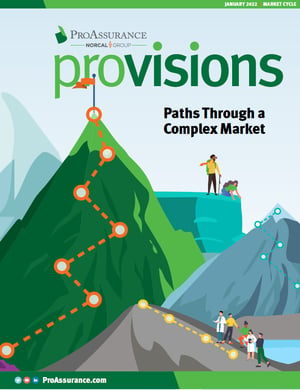
Market Cycle
The Numbers Behind the Shrinking Physician Market - A number of factors play into the state of the healthcare liability market, but the physician “market shrink”—whether from physicians leaving healthcare or choosing to be unemployed—is a major driver of risk and pricing decisions.

A Difference that Makes a Difference
Can Do vs Have Done - Many national carriers boast the same abilities, but there is a difference between the company that started offering a service this year and those that have been in the market for decades.
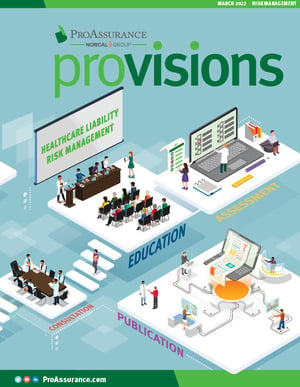
Risk Management
One-on-One Inspiration - ProAssurance’s Risk Management Consultants spend hours of valuable time with our insureds through consultations, assessments, and other encounters. Our team shares stories of the value of those conversations in their own words.

Telemedicine
Telehealth Use Remains Above Pre-Pandemic Levels While Compliance Risks Remain - The use of telemedicine rose significantly over the past two-plus years. However, quick adoption is rarely seamless, leading to a rise in liability concerns.
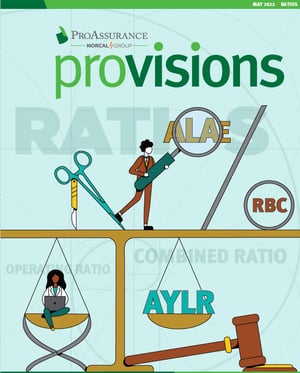
Ratios
Accident Year Loss Ratio - This issue took a deep dive into the ratios and figures ProAssurance teams rely on to do their work. Each provides unique value, but our look at the accident year loss ratio provides a helpful intro you can use to train new agents.
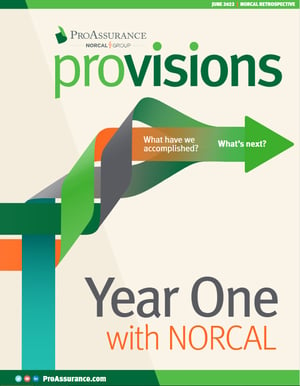
NORCAL Year One
Serving a National Market with Local Expertise - One of the largest changes ProAssurance made in the past year was the transition to a regional model—allowing our team to provide local expertise for you and your clients in a more effective way.
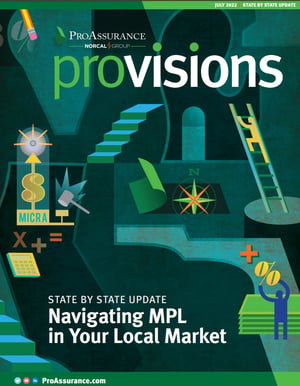
50/50
California/Modernizing MICRA - In addition to the likely implications to the California claims environment, we anticipate the MICRA Modernization will become a model for tort reform on a broader scale.
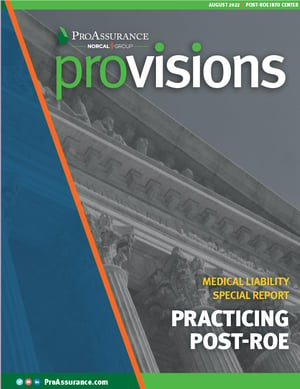
Practicing Post-Roe
Ectopic Pregnancies - The rules and regulations surrounding abortions are changing rapidly on a state-by-state basis. A hot button issue continues to be how to manage ectopic pregnancies while minimizing exposure to liability or criminal allegations.

New Business
Meet Your Underwriter - With the launch of our new series, we introduced you to some of our underwriting team, and what role they play in the organization.
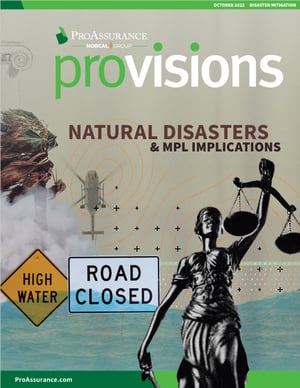
Natural Disasters
Mitigation & Preparation - The effects of natural disasters leave healthcare entities at risk for liability concerns. Our Risk Management team highlights key issues practices should be aware of, and how to mitigate the risk.
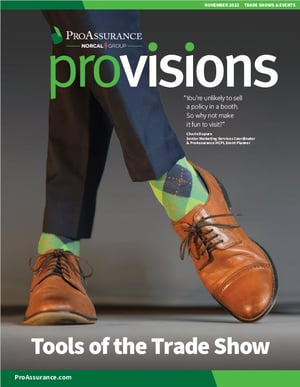
Trade Shows and Events
Making Memorable Connections - We share a bit about how live events and trade shows play into our marketing and brand strategy—and how you can take advantage of what we’ve learned.
The CURES Act
The 21st Century Cures Act, enacted in 2016, established new federal regulations on a variety of healthcare concerns including funding, research, access to new and experimental drugs, telehealth, and interoperability of health information technology and introduces a new phrase to the healthcare community: information blocking.

MPL Industry Overview
Summary of ProAssurance webinar MPL Market Update — Performance, Challenges, and Outlook presented November 2, 2022 with guest presenter William Burns, VP Research, MPL Association
✔ Little direct impact, but there will likely be legal ramifications though its full impact on claims, reserves, and paid loss development patterns is uncertain
✔ Physician retirements increased
✔ A heightened awareness among the jury pool of medical conditions, patient responsibilities of healthcare providers, and medical practices
✔ Potential for overly optimistic assumptions about its impact on claim frequency and severity
✔ Paid losses have slowed since 2019 due largely to a slowdown in loss payments
✔ 2021 DPW by NAIC Segment
47% Physicians — down from around two-thirds of the market 10-20 years ago
21% Hospitals
17% Other facilities
15% Other professionals
✔ A more concentrated market over the last decade
Growth by acquisition
Top three carriers hold a greater share of the market than 10 years ago (33% vs. 25%)
✔ Uncertainty over combined ration trends
Increasing after lows last decade
Softer pricing
Larger verdicts
Draw down of loss reserves
Accident year losses increasing
✔ Investment income near a three-decade low though steady over the last decade
✔ Surplus up, reserves and premiums remain low
✔ Surplus growth not coming from underwriting
✔ 47% of the market
✔ Physician market driven largely by specialists: Berkshire/MLMIC, TDC, ProAssurance
✔ DPW peaked in early 2000s largely due to rate increases
✔ Premiums remain low due to shrinking physician market
✔ Loss ratios down in 2021 but too soon to identify a longer term trend
✔ 21% of the market
✔ Top writers include both specialists and multi-line
✔ Steady premium growth this decade, mostly increase in excess coverage rather than exposures
✔ Loss ratios persistently high over the past decade
✔ Business likely significantly underpriced
✔ Consolidation continues but at a slower rate
✔ Hospital competition for patients leading to buying out physician practices
✔ 15% of the market
✔ Mostly steady premiums
✔ Rate increases tend to follow physician premiums
✔ Concerns over scope of practice risk could push rate increases
✔ Market is mostly MPL specialists plus single specialty (dentist, podiatry, etc.)
✔ Top two (CAN & Berkshire) hold a third of the market with competition below, led by ProAssurance
✔ 17% of the market
✔ Fastest growing segment
✔ DPW growth at 15-20% over past few years
✔ Shift in healthcare delivery growth; premium growth will likely follow
✔ Market is mostly E&S, dominated by multi-line carriers
✔ Frequency down, severity rising
✔ $10M+ verdicts increased through 2019
✔ The “COVID slowdown” is over; increasing since
✔ Factors contributing to larger verdicts:
Millennial jurors concerned more about fairness
Increasingly aggressive plaintiff’s bar
Tort reform limits softening
Litigation funding
Increased litigation advertising
More frequent batch claims
✔ Factors mitigating larger verdicts:
Firmer pricing
Higher quality of defense attorneys
Improved risk selection
✔ Impact on MPL industry not felt yet
✔ Higher inflation will increase liabilities (loss reserves)
✔ Underestimating inflation could result in inadequate prices
✔ Loss on sale of lower-yielding assets
✔ Possible mismatch of assets and liabilities
✔ Social inflation: difficult to measure but generally felt, more so in hospital space
✔ Poor results leading to firming of physician market
✔ Non-physician segments also firming
✔ Increased pricing in recent years… but only around 6% higher than in 2005 when inflation-adjusted to 2001
✔ Rate increases requested/approved significantly lower than indicated
✔ Reinsurance prices are up, while capacity is down
✔ Expanded use of captives
✔ (Possible) rising claim frequency
✔ Shift to value-base care
✔ Larger/more frequent batch claims
✔ Cyber attacks
✔ Conti (FDB as Ryuk) lied when it said it would stop targeting healthcare providers
✔ Increasing move to devices, IoMT, and online services increases attack surface
Keep Our Customers:
2022 RETENTION CAMPAIGN UPDATE

As you may recall from our February 2022 issue, ProAssurance conducts an annual retention campaign thanking our insureds and offering them a complimentary resource, usually a book.
Involving a series of direct mails, we’ve seen great success in the past with reply rates up to 25%. Last year’s campaign was largely successful, with an overall response rate of approximately 23%. This year’s campaign saw a bit of a drop-off, with reply rates of around 13%.
2022 CAMPAIGN RESULTS
In 2021, we adapted the retention campaign to welcome NORCAL Insurance Company policyholders to ProAssurance. The response rate from NORCAL insureds was better than expected at 17.5%, which we viewed as excellent given our audience’s limited familiarity, at the time, with ProAssurance. This year, however, the NORCAL insureds’ response rate lagged—at about a third of the rate of ProAssurance insureds—and lowered the total response rate in 2022 to about 13%. We are excited about our upcoming 2023 campaign and look forward to further developing our insured relationships.
.png?width=300&name=MicrosoftTeams-image%20(46).png)
2023 CAMPAIGN PREVIEW

The 2023 retention campaign will feature Deep Medicine: How Artificial Intelligence Can Make Healthcare Human Again by Eric Topol, MD. Topol is a world-renowned cardiologist and executive vice president of Scripps Research. He is one of the top 10 most-cited researchers in medicine. Aside from Deep Medicine, he has published two other best-selling books: The Creative Destruction of Medicine and The Patient Will See You Now. In Deep Medicine, Topol explores how artificial intelligence (AI) could dramatically reshape the healthcare industry, from how illnesses are diagnosed to the ways patients are cared for. He argues that the best outcomes stem from collaboration between doctors and AI, and implores decision makers to leverage AI for routine healthcare tasks. According to Topol, AI has the potential to transform everything doctors do, from notetaking and medical scans to diagnosis and treatment, greatly cutting down the cost of medicine and reducing human mortality. By freeing physicians from the tasks that interfere with human connection, AI will create space for the real healing that takes place between a doctor who can listen and a patient who needs to be heard, he says.
For more information on how our retention campaign works, see our February 2022 issue. If you’d like to receive the complimentary book, email AskMarketing@ProAssurance.com letting us know your mailing address. We appreciate everything you do to place and retain business with ProAssurance. If you have any questions about the retention mailings, feel free to email AskMarketing@ProAssurance.com.
MICRA Modernization: Keeping You Informed

The long-anticipated MICRA Modernization legislation takes effect January 1, 2023. Overall, we believe the new law strikes a sensible balance: It provides compensatory justice for injured patients while maintaining an overall healthcare system that is accessible to all Californians.
Across the country, state tort reform laws are continuing to erode as the constitutionality of such laws is consistently challenged. Overall, we’re pleased that this new law in California will extend the long-term predictability and affordability of MPL insurance for those providing medical care in California, while implementing a fair and reasonable increase to limits on non-economic damages.
Earlier this year, ProAssurance professionals Gina Harris, Lucy Sam, and Shep Tapasak discussed important key provisions of the new law in “Managing the New MICRA: Ways This California Law Affects Health Care” in Risk & Insurance.
To learn more, visit the California Medical Association’s MICRA Modernization 2022 site. The full text of the law is available on the California Legislative Information site.

Overcoming The Holiday Mindset
When I noticed holiday decorations on display during a visit to a department store in September, I thought, Are you kidding me? It’s 90 degrees outside, and Santa is still at the beach. Too soon! It’s not that I don’t like the holidays; I do. Thanksgiving, Christmas, Hannukah, and New Year’s are joyous times for celebrating with families, friends, and co-workers. But they can interfere with the regular flow of business.
Healthcare personnel frequently respond to meeting requests from salespeople at this time by saying, “Check back after the holidays.” As a commission-based salesperson, I never had that luxury, as there was always pressure to finish the year strong. Customer service activities kept me busy, but the interruption to selling left me frustrated.
It took a few years before I figured out how to stay productive between Thanksgiving and New Year’s. I focused less on making sales calls and more on business planning for the following year. I’d work on my annual sales forecast (which in my early years was little more than a best-guess exercise in wishful thinking), but not being in the field made me feel like a slacker. One mid-December day, while sitting at my desk, addressing holiday cards and going stir-crazy, the urge to get out of the office was overwhelming. I decided to visit some accounts, not with the intent to make sales or service calls, but just to be with customers.
I discovered that medical practices and hospitals weren’t seeing many sales reps during this time (because most reps obeyed the check-back-after-the-holidays rule). It was easy to get time with doctors and other staff members, especially by saying, “This isn’t a sales call; it’s just a friendly holiday visit.” Of course, bringing along some holiday cheer in the form of food helped get in the door.
I thanked the doctors for doing business and meeting with me during the year. Then I'd ask, "How can I best serve or support you and your practice in the New Year?"
Most thanked me for asking but said they didn't know. I then asked, "Should we discuss a way for you to X after the New Year?" with X being a relevant issue or concern common in their type of practice.
One of two things happened. The client/prospect would say, "Sure, let's talk about that next time." But many said, "Let's discuss that now if you have time."
Not only was I getting time with customers during the holidays, but I also got time with surgeons who wouldn't meet with me during the year.
I changed from having an I-can't-wait-until-the-holidays-are-over attitude to embracing the holidays as a warm-up to business in the New Year. And yes, it was also the perfect time to express gratitude and find new ways to serve prospects and clients.
Speaking of gratitude, please allow me to express some to you. You're one of the unrecognized heroes in healthcare who makes a difference by working behind the scenes. Your efforts make it possible for healthcare professionals to confidently deliver patient care, knowing they're financially protected in the event of a lawsuit. Thank you for being so committed to serving the industry.
And thank you for allowing me to share my thoughts with you in ProVisions throughout the year. Congratulations on making it through 2022 (and the holidays!). May 2023 provide abundant opportunities for personal and professional growth and happiness.

Written by Mace Horoff of Medical Sales Performance
Mace Horoff is a representative of Sales Pilot. He helps sales teams and individual representatives who sell medical devices, pharmaceuticals, biotechnology, healthcare services, and other healthcare-related products to sell more and earn more by employing a specialized healthcare system.
Have a topic you’d like to see covered? Email your suggestions to AskMarketing@ProAssurance.com.
.png?width=300&name=MicrosoftTeams-image%20(28).png)
Top 10 Healthcare Industry Predictions for 2023
The year 2022 is almost behind us and the healthcare industry is preparing for what promises to be a most interesting 2023. Some predictions are pure hunch; others are extensions of trends observed in 2022 that will continue into 2023; and others still are a reflection of my deepest hopes—some of which I hope I will nudge into being by writing it here in this column.
Author Sachin H. Jain dives into topics such as AI, Medicare Advantage, private equity, COVID, and more in his analysis of things to come.
View the full article.
Source: Forbes
About The Comments Section
The Comments Section is a recurring feature that focuses on an industry article in line with the monthly theme. ProAssurance thought leaders offer insights on the article and how the topic relates to our industry.

“As I was reading the Top 10 2023 predictions, the first eight were about the business of medicine (reimbursement, potential mergers and acquisitions, and venture capital dollars), science (impacts of “big pharma” and technology), and care delivery (hospital home). What caught my interest were the last two addressing human capital(physicians, nurses, other healthcare providers, and leaders).
Investing in humans, taking care of humans, and curating leaders who understand providing care is both an art and science might be a game changer? Taking care of our physicians, nurses, and other healthcare professionals first, I believe, is the most important key to unlocking true value-based patient care. Patients and families remember those physicians, nurses, and providers who are compassionate, have time to hold their patients’ hand, look them in the eye, sit with them, and connect human-to-human. They are as the commercial says ... priceless. We have made huge advances in technology and science, and we will continue to do so. As we look to the future, maybe we should invest time in our physicians and care givers by cultivating the art of healing?”

“It is interesting from a risk management perspective to see the effects of private equity investments in healthcare. A recent JAMA article studied insurance claims to identify medical practice changes after acquisition including increased healthcare spending and utilization. Injury from overtreatment can be difficult to defend.”
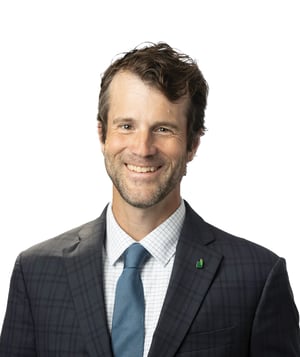
“My 2023 prediction is that Amazon will acquire a major pharmacy chain or a grocery chain with a pharmacy operation (Whole Foods does not have a pharmacy). And my 2024 prediction is it will be blocked by the FTC. The author addresses Big Tech and healthcare in #7 but thinks an acquisition like this is unlikely.
One more tech-based healthcare prediction: I think Zoom will deploy some emergency health alerts at scale, and eventually all online meeting companies will have some sort of health monitoring embedded in their services. Think ‘what iPhone now does to detect car crashes, Zoom will do for strokes.’”
.png?width=2000&height=373&name=MicrosoftTeams-image%20(28).png)
The Alaska Supreme Court has ruled that a 46-year-old law limiting financial awards in medical malpractice lawsuits is unconstitutionally biased against Alaskans with medical insurance. Between 2012 and 2022, 197 malpractice cases resulted in payments to victims in Alaska, according to statistics kept by the U.S. Department of Health and Social Services. (Alaska Public Media)
Our California HCP applications have been updated to include branding changes, and new agreements and notices. As a reminder, the most up-to-date versions of our applications can always be found in the NORCAL coverages by state library, or the ProAssurance application library. Guidance on new business placements by state and issue company is available in the Producer Guide. For further assistance, you can always contact your ProAssurance underwriter.
North Carolina enacted a law early in the coronavirus pandemic that gave medical providers near-absolute immunity from civil liability. Now, the nation’s largest for-profit health care system could use that law to quash a medical malpractice claim that has nothing to do with COVID. Some legislators say they want to revisit the law. (WHQR)
The panel urged the Supreme Court to take up the case, more than five years after justices issued a closely watched decision that backed disclosure of records. (ALM Global, LLC)
For the 20th year, Agency for Healthcare Research and Quality (AHRQ) is reporting on healthcare quality and disparities. The annual National Healthcare Quality and Disparities Report is mandated by Congress to provide a comprehensive overview of the quality of healthcare received by the general U.S. population and disparities in care experienced by different racial and socioeconomic groups. The report is produced with the help of an Interagency Work Group led by AHRQ. (AHRQ)
Holiday marketing campaigns can be fun yet stressful. The season comes with constant deadlines making it easy to forget marketing etiquette. Don’t worry! This list includes many useful tips to make your holiday outreach campaigns stand out, generate goodwill, and deliver your message. (Content Writers)
.png?width=300&name=MicrosoftTeams-image%20(44).png)
Want to read more?
To see previous issues, visit ProVisions Home.









.png?width=300&name=MicrosoftTeams-image%20(39).png)

